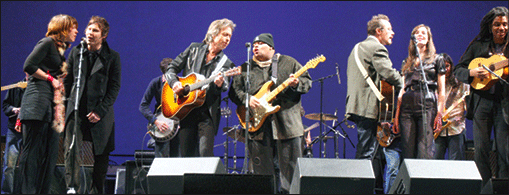By Todd Simmons
Bob Dylan’s sudden, controversial move to electric rock music in 1965 with “Subterranean Homesick Blues” and “Maggie’s Farm” signaled the beginning of a wild ride for the young troubadour from Minnesota turned Greenwich Villager. A ride that would cement the impression that, aside from John Lennon, there has hardly been a more polarizing figure in modern music history. Although certainly not without his ambitions, the reluctant “voice of a generation” and his early Woody Guthrie-inspired “protest songs” were embraced by various civil rights causes and propelled him into the spotlight as a serious young man, alone with his peculiar vocals and his acoustic guitar. When a few years later he recruited a band (The Hawks) to play electric rock and roll music, it caused quite a stir on both sides of the pond. Where he was just “tired of playing alone” with his guitar, as he told Newsweek then, the folk scene instead saw it as selling out — a betrayal and an abandoning of the cause. As Lenny Kaye would put it at last week’s New York Guitar Festival [NYGF] tribute to Dylan at the Winter Garden, nobody had yet heard electric “pop music” that “didn’t just say nothing.” In one fell swoop, Bob Dylan made it possible to write rock and roll songs about something aside from cars and love, and he turned it up loud in the process.
Though not a particularly influential guitar player as much as a seminal lyricist, songwriter and enigma, the NYGF dedicated their opening show to honoring the notorious bootleg recording of Dylan’s “Live at the Royal Albert Hall” show of May 17th, 1966, in which Dylan played two sets — the first acoustic, the second electric — with back-up musicians who would later become The Band. The album was later discovered to have been actually recorded in Manchester, but that’s beside the point. With host John Schaefer of WNYC introducing the musicians and filling time during the many set changes, the festival line up systematically, and at times, haltingly worked through the entire concert plus an encore of “Knockin’ on Heaven’s Door”. Where the performances were mostly very good, the format provided challenges that were difficult to overcome. With a separate act for every song, it was nearly impossible to keep any real momentum going throughout the concert. Following inspired performances, there would be yet another break in the action. Although a good source of information, Mr. Schaefer’s job was made difficult by the start-stop format and his between-song banter became a little tedious and wore thin after a while, and ultimately seemed as though there was more talk than rock in the end.
The annual selection and performance of a well-known record has become a traditional segment of the New York Guitar Festival and remains one of the event’s trickiest experiments. By exploring the ubiquitous work of Bruce Springsteen, The Grateful Dead and this year Bob Dylan, they are creating a challenge for themselves, one they have for the most part met. Instances of women singing songs made famous by men, and genre rearrangements, are a couple examples of the experiment paying dividends. And while some of the spare reinterpretations of songs left one longing for the originals, there were several standout moments that captured the spirit of the evening. When Marc Ribot appeared unexpectedly, his electric guitar work was explosive and illustrated how jarring it might have been for those people in the crowd in England in 1966 to hear Dylan plug in. Magnetic performances by Stevie Jackson of Belle and Sebastian, The Last Town Chorus, Lenny Kaye, Chocolate Genius Inc. and Toshi Reagon also gave the program a jolt.
The positive impact of a free concert Downtown during winter in New York cannot be overstated. Everything in this city seems to cost a fortune, so to get some top players breaking out their best Dylan cover is a rare gift to music fans and should be encouraged. The New York Guitar Festival continues to push the boundaries of pop music interpretation and provides a forum for musicians to stretch out and explore the possibilities of electric and acoustic guitar sounds — with or without their muses.


































